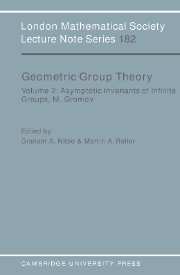6 - Semi–Hyperbolic Spaces
Published online by Cambridge University Press: 04 May 2010
Summary
K≤ 0 and semi–hyperbolicity; coning and combing; rank and geometry of flats; Tits boundary and Morse landscape at infinity; minimal surfaces and norms on homology; group actions with K≤ 0; semi–hyperbolic constructions and generalizations.
We start this section with a little propaganda for groups acting on spaces with K≤ 0 and then we explain the difficulties in globalizing the conception of non–positive curvature to a notion of semi–hyperbolicity.
6.A. Examples of K≤ 0. A geodesic space has K≤ 0 if the distance function there is more convex than that on in the sense of CAT (see [Gro]14, [Gh–Ha], [C–D–P]). This includes Riemannian manifolds with the sectional curvature K≤ 0. Another elementary example is provided by 2–dimensional simplicial polyhedra X satisfying the ⅙–condition: X contains no subpolyhedron isomorphic to the cone over a closed polygon with less than six edges (i.e. pentagon, quadrangle or triangle).
One may think of K≤ 0 as the limit case of the negative curvature condition K< 0 and regard (groups acting on) spaces X with K(X)≤ 0 as rare and exotic species compared to hyperbolic groups and spaces corresponding (morally rather than factually at the present state of knowledge) to K< 0. This point of view is justified in the local differential geometry as the curvature tensors with K< 0 are open and dense among those with K≤ 0.
- Type
- Chapter
- Information
- Geometric Group Theory , pp. 119 - 174Publisher: Cambridge University PressPrint publication year: 1993



